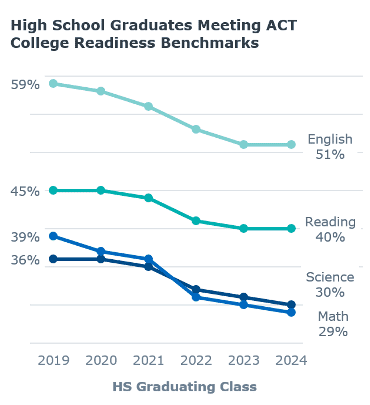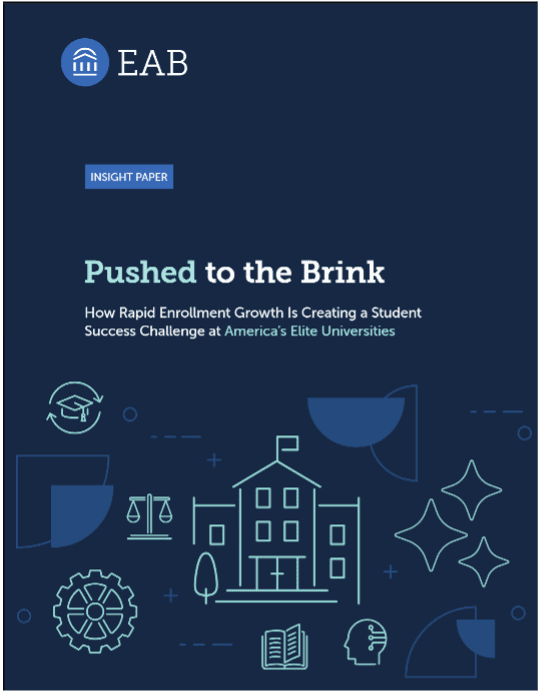3 hidden retention challenges facing higher ed in 2025
As higher education enters the midpoint of the 2020s, institutions face a wide range of challenges threatening retention and student success. Some, like cost and affordability, are longstanding, while others—such as the growing demand for mental health and wellness services—have rapidly increased in significance.
Hidden among these macro challenges are three risks that are newly emerging and thus easy to overlook. They are likely to affect different segments of higher education in different ways: some institutions may feel their impact profoundly, while others might not be affected at all.
As the new year begins, we encourage you to reflect on which of these under-the-radar challenges might influence your campus and to what extent. Here are three hidden retention challenges that could demand your attention in 2025.
Challenge 1: Addressing the “Murky Middle”
The “murky middle” refers to students midway through their academic careers (30–90 credits) with GPAs between 2.0 and 3.0. These students often persist at lower rates but are frequently overlooked by student success teams that focus primarily on first-to-second-year retention. Recent data suggests that attrition issues might be even more of a concern with this current cohort of sophomores and juniors.
Why It Matters

ACT results reveal a notable decline in academic preparedness among recent high school graduating classes, measured by their likelihood of passing college-level courses in the four critical subject areas tested by ACT (English, reading, science, and math). This decline is especially clear as students who were high school freshmen and sophomores during the pandemic-related learning disruptions of 2020–2021 are now starting college.
These cohorts missed critical instruction during a foundational period for subjects like algebra, which is essential for future STEM success. Four years later, these students are in their first and second years of college and are significantly less prepared academically than the college seniors who are just two years ahead of them.
Strategies to Support the Murky Middle
Expand First-Year Support Services:
Develop strategic interventions by adapting first-year support systems to accommodate sophomore needs, especially for detecting early academic struggles. Not all first-year services need to be expanded, so be sure to take a close look at the needs of your sophomores as part of this process.
- See how strategic interventions drove student success in EAB’s Data-Driven Student Support Cohort.
Introduce Sophomore-Specific Engagement Programs:
Focus on persistence by creating or enhancing programs tailored for sophomores. Notably, this is the best time to get students started on their post-graduation career exploration. Giving sophomores a clear goal can help them stay motivated through graduation.
- Enhance career readiness for college students with these four tech-focused strategies.
Support Sophomores with Long-Term Academic Planning:
One of the biggest reasons sophomores leave before junior year is if they fail to get admitted to the upper division of a selective major like nursing or business. Make sure all sophomores who are pursuing a selective major have a desirable parallel plan in place that they can switch to if things don’t work out.
Challenge 2: FAFSA Delays Increase Transfers
The rollout of the revamped FAFSA form in 2024 caused significant delays in financial aid decisions, disrupting incoming student enrollment. The impact was uneven across the sector. Data from the National Student Clearinghouse suggests that two-year colleges experienced less disruption than four-year colleges, as evidenced by stronger incoming enrollment growth. This might mean that some students who would have otherwise chosen expensive four-year schools instead opted to stay closer to home and attend their local community college.
Why It Matters
For many students, starting postsecondary education at a less expensive community college offered a practical solution amid financial uncertainty. However, these decisions could ultimately lead to an uptick in transfer activity as students reconsider their long-term goals once the financial aid landscape stabilizes.
What happens next depends on the perspective of your institution. Four-year institutions that missed out on these students as first-years will be looking to attract them as sophomores in Fall 2025. On the flip side, the local open-access colleges that currently enroll these first-year students will want to fight hard to keep them.
Strategies to Manage Transfer Trends
Emphasize Retention Through Tailored Messaging and Services:
Community colleges and regional institutions should emphasize the value of staying enrolled, their 2+2 pathways to bachelor’s degree programs, and the lower cost of tuition and expenses.
- Explore tech-enabled strategies to help community colleges overcome FAFSA setbacks in this blog.
Streamline and Communicate Credit Transfer Policies:
Simplify the transfer process by optimizing credit articulation agreements and communicating how credits apply to new programs. Students are more likely to transfer when they know how their credits will apply to their new program.
Engage Prospective Transfers Through Proactive Outreach:
All institutions can leverage CRM tools like polls and surveys to identify and engage prospective transfer students early, either to convince them to stay or to ensure that they transition seamlessly to their next school.
- Watch our on-demand session covering three proactive strategies that drive student success and retention.
Challenge 3: Resource Strains at Highly Selective Institutions
The middle of the decade brings new student success challenges for some of the most selective colleges in the country—those with large endowments, top rankings, and retention rates exceeding 90%. These institutions have seen enrollment booms enabled by test-optional policies. As a result, they’ve been growing enrollment and increasing diversity on campus even as the rest of the sector declines.
Why It Matters
This growth is straining campus resources. While higher enrollment numbers demonstrate a broader commitment to accessibility, they also put pressure on infrastructure, especially in areas critical to student success. Compounding the challenge, elite colleges are also experiencing the changes in student readiness described above, meaning that they are not only trying to serve more students, but these students may also have more needs than before.
So far, much of the focus has been on expanding financial aid and mental health services, while advising and academic support have received comparatively less attention. As more students enter these highly competitive academic environments, the need for additional advising and tutoring capacity is growing.
 A Must-Read for Selective Colleges
A Must-Read for Selective Colleges
Your Guide to Protecting Student Success Amid Growth
Discover how rapid enrollment growth is reshaping student success at elite universities. This insight paper provides actionable strategies to tackle capacity challenges, deliver personalized support, and maintain your institution’s reputation for excellence.
Strategies for Selective Institutions
Streamline Operations with Technology:
Student success CRMs like Navigate360 save time on the everyday tasks like appointment scheduling, communications, and record keeping. Emerging artificial intelligence tools like generative emails and chatbots that can help student success teams save time and devote more attention to students.
- Learn how Dickinson College is using technology to break down barriers and deliver wrap-around student support in this on-demand webinar.
Enhance Faculty-Student Engagement:
Training faculty on the tools used by your student success team can ease the burden on centralized support services while improving student outcomes. Not all faculty at elite research institutions will be interested partners, so we advise starting by partnering with the faculty teaching foundational math, English, and general education courses. Performance in these courses is an indicator of overall success, and the targeted use of early alert systems in these courses could have an institution-wide impact.
Beyond 2025: Preparing for Long-Term Retention Challenges
These challenges will likely persist beyond 2025. Trends in academic preparedness, enrollment shifts, and resource constraints suggest that institutions must adopt long-term strategies. Investing in robust student success infrastructure—including people, processes, and technology—is key to sustaining retention rates and fostering student achievement.
Ready to get started with Navigate360?
With over a decade of experience improving student success, we’re here to support every step of the student journey. Fill out the form to connect with an expert and see how Navigate360 can streamline campus-wide success.

More Blogs

What are students asking university chatbots?

4 lessons about the “make-or-break year”

 A Must-Read for Selective Colleges
A Must-Read for Selective Colleges